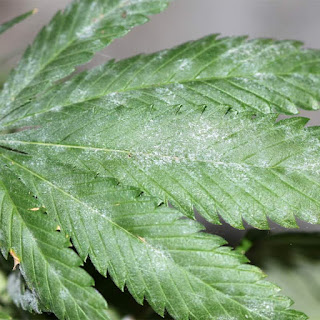Cannabis Diseases
Cannabis plants are susceptible to various diseases caused by fungi, bacteria, viruses and pests. These diseases can affect the quality and yield of cannabis products, as well as pose health risks to consumers. In this blog post, we will review some of the most common cannabis diseases and how to detect and treat them.
Powdery Mildew: This is a fungal disease that appears as white or gray powdery spots on the leaves and stems of cannabis plants. It can reduce photosynthesis, growth and potency of cannabis plants, and can also contaminate the buds with spores. Powdery mildew thrives in humid and warm conditions, so it is important to maintain good ventilation and air circulation in the growing area. To prevent powdery mildew, you can spray your plants with a solution of water and baking soda, milk, or neem oil. To treat powdery mildew, you can remove the infected parts of the plant and apply a fungicide.

Botrytis or Grey Mold: This is another fungal disease that affects the buds of cannabis plants. It causes brown or gray fuzzy mold to grow on the buds, which can rot them and produce toxins that are harmful to humans. Botrytis can spread quickly in moist and cool environments, especially during the flowering stage. To prevent botrytis, you should avoid overwatering your plants, prune excess leaves and branches, and keep the humidity low in the growing area. To treat botrytis, you should cut off and dispose of the infected buds as soon as possible, and spray the remaining plants with a fungicide.
Root Rot: This is a bacterial disease that affects the roots of cannabis plants. It causes the roots to turn brown or black, slimy and mushy, which can prevent them from absorbing water and nutrients. Root rot can also attract fungus gnats, which can further damage the roots. Root rot can occur due to poor drainage, overwatering, low oxygen levels, or contaminated soil or water. To prevent root rot, you should use well-drained soil or hydroponic medium, water your plants only when needed, aerate the water or soil, and sterilize your tools and containers. To treat root rot, you should remove the infected plants from the growing area, trim off the diseased roots, and replant them in fresh soil or medium.
Spider Mites: These are tiny pests that feed on the sap of cannabis plants. They can cause yellow or white spots on the leaves, webbing on the undersides of the leaves, and reduced growth and yield of cannabis plants. Spider mites can multiply rapidly in hot and dry conditions, so it is important to monitor your plants regularly for signs of infestation. To prevent spider mites, you can introduce predatory insects such as ladybugs or lacewings to your growing area, or spray your plants with a solution of water and soap, alcohol, or neem oil. To treat spider mites, you can use insecticidal sprays or miticides.
Mosaic Virus: This is a viral disease that affects the leaves of cannabis plants. It causes yellow or green mosaic patterns on the leaves, distorted leaf shapes, stunted growth and reduced yield of cannabis plants. Mosaic virus can be transmitted by insects such as aphids or thrips, or by contact with infected plants or tools. There is no cure for mosaic virus, so prevention is key. To prevent mosaic virus, you should avoid planting cannabis near other crops that are susceptible to mosaic virus such as tomatoes or peppers, keep your growing area clean and free of weeds, and disinfect your tools before and after use. To treat mosaic virus, you should remove and destroy any infected plants as soon as possible.





Comments
Post a Comment